No Expectation of Privacy
When I worked at ___________, a message would pop up on my computer screen each morning when I logged in to begin work. The message warned me that, in conducting work on the company computer, I should have no expectation of privacy.
But I couldn't see anyone watching me. My cube mate still played Bejeweled. I still coded Architecture Addiction. That dumb anonymous pixel lawyer felt as non-threatening and irrelevant as any web site's Terms and Conditions gateway.
I was complacent to the fact that "somebody somewhere" was privy to my every keystroke, that my online life, for this unknown corporate voyeur, was on display.
Facebook is kind of the same. I'm on there because my friends are on there. When I post, I'm complacent about those other "friends" who will also peek into my life, those people who I only friended because I was in a good mood when they asked me, but now feel weird about defriending. And, should I ever fail to keep my habit of navigating Facebook's mercurial privacy settings, I should also have no expectation of privacy from random internet people as well.
We post on Facebook because we want to be noticed and acknowledged. If we didn't want that, we would keep private journals instead.
Facebook is our modern era's equivalent to the Palais Garnier in the late 1800's -- a place to see and be seen.
(But Facebook is also not like the Palais Garnier in that I don't think anybody hung out there all day, showing off pictures of their cats.)
We want to be seen. We want to create a manifestation of self that is loved and accepted by others. A manifestation of the Hero Self. Or the Misunderstood Genius. Or the Small Town Wonder. But sometimes it's fake. Facebook has created a stage where anybody can be their own brightest star in the universe. When we update Facebook with our goings-on, we are posing for our audience, affecting the way we tell the stories of our lives. We are acting. We position ourselves. We are always on.
When I spend too much time participating in these types of social conditions, it starts to feel oppressive. I start to feel like I have to perform because I know I'm being watched. When I'm on -- in public, or on stage, or on Facebook -- too much without respite, I feel like I lose the connection with my private self.
And, thanks to Facebook, I now know much more than I ever wanted to about my "friends." I know what they call dinner, what misguided articles they read, how much they hate traffic, waiting in line, and the TSA. Facebook has provided me with a constant window into the most banal details of their lives. I struggle with questions such as "Should I defriend this guy for being a fucktard?" or, more likely, "Why am I even friends with her?" and even "Should I just close my Facebook account?"
When I know too much about somebody else thanks to their participation in these types of social conditions, when all the mystery is swept away by too-revealing status updates, or too many pictures of their parties, it's...boring. Nothing is left to the imagination.
I think of the social phenomenon of Facebook when I see renderings of all-glass walled buildings, such as Columbia University Medical Center's new Medical and Graduate Education Building (Diller Scofidio + Refro, Gensler).


Even the New York Times seemed confused:
"Because of an editing error, a report in the “Arts, Briefly” column on Wednesday about plans for Columbia University Medical Center’s new education building described incorrectly an image of the building supplied by the architecture firm Diller Scofidio + Renfro. While the image appears to be a cutaway rendering that shows the interior, it is actually a rendering of the building." [Emphasis mine.]
The little rendered people, to be replaced by living, breathing graduate students, will be on display as they move about the space of their medical educations. Like their online lives, they will have no expectation of privacy. No mysteries with which to behold with wonder. No puzzles to tease apart. A medical education building without secrets contains the message that the field of medicine, too, has finally been liberated from its secrets. This is false, and worse, is dangerous to believe. A doctor cannot peer so easily into the causes of mysterious diseases the same way that she could peer though three of her classrooms at once as she did while at Columbia.
Columbia's building is simply the latest in a relatively recent rash of the show-all building typology. A quick look on Sciame's own site reveals more.
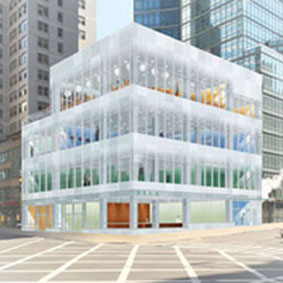 201 East 57th Street – M&B Building |
 CUNY-CityTech |
 New 42 Studio |
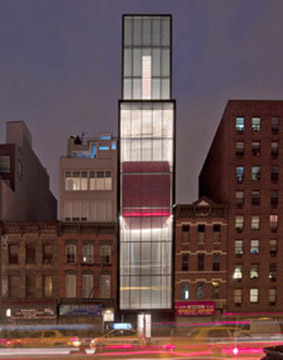 Sperone Westwater Gallery |
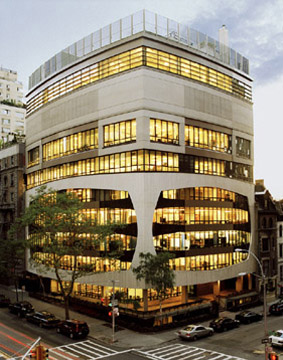 Calhoun School |
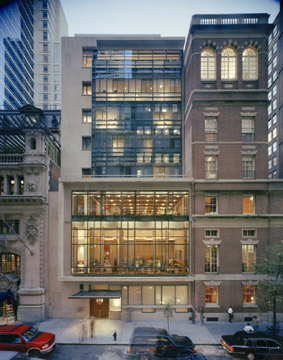 Harvard Club |
My own undergraduate university has a large building in the center of campus called The Commons. In the center of The Commons is a large open area filled with small tables and chairs. The space was meant to be flexible and open. "Anything could happen there!" You could read your biology text book. You could eat some gross crap from the adjacent food mart. You could squeeze around some tables with your friends, trying to create an intimate atmosphere in this giant, brightly lit space.
And therein lies the problem.
In A Pattern Language, Christopher Alexander recommends that people have a way of creating intimate spaces.
Pattern 148: Small Work Groups: "When more than half a dozen people work in the same place, it is essential that they not be forced to work in one huge undifferentiated space, but that instead, they can divide their workspace up, and so form smaller groups.""In fact, people will feel oppressed, both when they are either working in an undifferentiated mass of workers and when they are forced to work in isolation. The small group achieves a nice balance between the one extreme in which there are so many people that there is no opportunity for an intimate social structure to develop, and the other extreme in which there are so few that the possibility of social groups does not occur at all."
I tried to like The Commons. But every time I sat in there, to draw, to study, to read, a biological instinct bade me to leave. What I needed was a cozy little space, a private space, a space from which I could observe the world - or not - while still feeling protected.
My graduate school likewise suffered from a dearth of private spaces, a problem that slowly dawned on us one by one as we tried in vain to find a single place in the entire building where one could make a private telephone call, something that becomes necessary in any program whose schedule precludes personal time away from school. And I imagine medical students to be just as time-starved as architecture students are.
Alexander also recommends that spaces be designed with an Intimacy Gradient (Pattern 127). In a statement that seems almost directed at spaces like The Commons or the show-all buildings like Columbia's, he writes, "This homogeneity of space, where every room has a similar degree of intimacy, rubs out all possible subtlety of social interaction in the building."
Alexander references this pattern in a related pattern called A Room of One's Own (Pattern 141) by stating that "No one can be close to others without also having frequent opportunities to be alone." Alexander tells us about the work of two American sociologists, Foote and Cottrell, who write:
"There is a critical point beyond which closer contact with another person will no longer lead to an increase in empathy. (A) Up to a certain point, intimate interaction with others increases the capacity to empathize with them. But when others are too constantly present, the organism appears to develop a protective resistance to responding to them...This limit to the capacity to empathize should be taken into account in planning the optimal size and concentration of urban populations, as well as in planning schools and the housing of individual families. (B) Families who provide time and space for privacy, and who teach children the utility and satisfaction of withdrawing for private reveries, will show higher average empathic capacity than those who do not." (Foote, N. and L. Cottrell, Identity and Interpersonal Competance, Chicago, 1955, pp. 72-73, 79.)
Where The Commons failed, another building on campus provided a partial solution. An giant old brick building, riddled with innumerable small rooms, reported to be haunted, and used mainly as a practice space for music majors, Ridenbaugh fulfilled all of my small cozy space needs. Any number of people could use Ridenbaugh at once and still feel deliciously alone. It was the perfect respite from the show-all Commons.
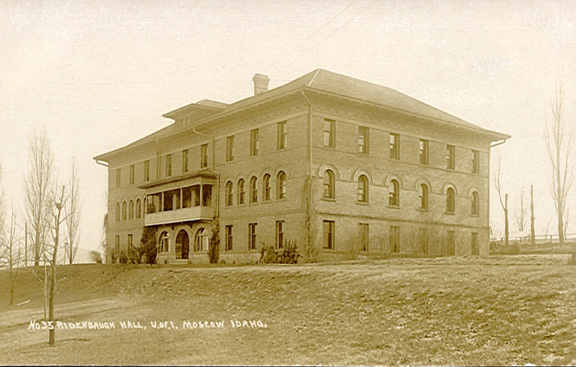
But here, again, is another problem. I could go to The Commons to experience total exposure, or I could go to Ridenbaugh to experience total seclusion. Neither is a ideal solution.
Pattern 146: Flexible Office Space: "A clue to an altogether different approach comes from the fact that the organizations which use converted houses as office space have no difficulty with this problem at all. Indeed, it appears that these old buildings actually provide more real flexibility than the apparent flexibility of modular partitioned offices. The reason is simple. In these old houses, there are many small rooms, and many partially defined spaces, usually interconnected in a variety of ways."
A perfect solution would be a building made up of some totally private spaces, many many partially private spaces, and a few public spaces. But even those people using public spaces should not be completely exposed behind walls of glass like the gorillas at the zoo.

Pattern 151: Small Meeting Rooms: The larger meetings are, the less people get out of them. But institutions often put their money and attention into large meeting rooms and lecture halls."
In the Columbia building, there are a few rooms set apart from the open expanse that borders the building's central core; we can see two from the rendering (at the top of this page, on the right). It's fair to put these in the partially private category. There need to be many, many more such spaces of a variety of sizes in order to fulfill the needs of the human psyche. If this building has any private spaces (other than, I hope, the rest rooms), I can't tell from any of the other renderings available online. All I can really tell from the renderings is who no one that uses this building should have any expectation of privacy.
+ Did you enjoy this?
1. Like Architecture Addiction and you'll receive notifications on Facebook when there's something new on the site.
* Some browsers don't show the Facebook Like Box -- and no one seems to know why! If you don't see our Facebook Like Box, you can use this link to visit Architecture Addiction on Facebook.
2. Donate a book to the Architecture Addiction Library
3. Support this site. People typically give $12. You help make Architecture Addiction possible. Thank you for your support!
4. And tell me what you think... I really want to know!